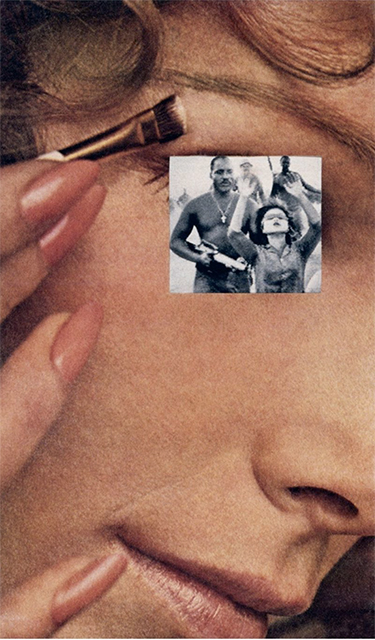Martha Rosler did a series of collages called House Beautiful: Bringing the War Home. They are all using images (mostly from the magazine House Beautiful to show the extremes of what was being seen on TV during the Vietnam war, the first war extremely exposed on TV. She used this series as a protest against the war, the images show the war as literally in the home, some with images of women cleaning and just outside their window was the war. Maybe it had to do with the way the war was so in your face yet people were going on with it as if it wasn’t a problem and all was ok. This one Makeup/Hands Up, I chose because of the simplicity. I really like collage art because it shows images, which we are familiar with, and makes such a statement because of the way the story can be told out of combining images we are already familiar with seeing.
Category Archives: Discussion 13
Jocelyn Alonzo Reflection 13
My thoughts on recent event about overturning women’s right to abortion. I think that abortions should be available to anyone that needs it. I am pro-choice when it comes to abortions. Abortions needing in present day because they are many different reasons why people need to have abortions. Let’s say that a woman is raped and she gets pregnant by her molester, her keeping the baby while cause emotional trauma and maybe even lead her to suicide. Banning abortions would lead to preform abortions that aren’t safe. The government shouldn’t have the right to make decision about what women should do with their body. This ban of abortion would push us back many year when woman didn’t have rights.
Jesica Rodriguez – Discussion 13

I chose this painting, Self-love a painting by Mia Adams which was uploaded on July 16th, 2019. This painting has a caption that says, “The greatest love of all is the one you have for yourself because it can’t love yourself, it’s impossible to love anyone else”. I chose this painting because in today’s society there are a lot of females who are dealing with how to love themselves. Meaning that a lot of females nowadays tend to get plastic surgery anywhere on their body. Either it’s getting bigger boobs or ass just to try to get the male’s attention or that when they see other women who have all this plastic surgery they feel some way about their body. Every female should love her own body and not have people telling her that her body is ugly. So many females have died doing plastic surgery on their bodies just so their bodies can look good or in some cases please their husbands or boyfriend. This activates me in a way that if I know someone who is dealing with not being able to love themselves I will do my best to help them love themselves. Or are body shaming themselves I will help in guiding them that they don’t need to go get surgery and make their body good. They should appreciate and love themselves and their body. We all come in different sizes and body shapes. You don’t always have to impress anyone but yourself.
REPOST DISCUSION #13
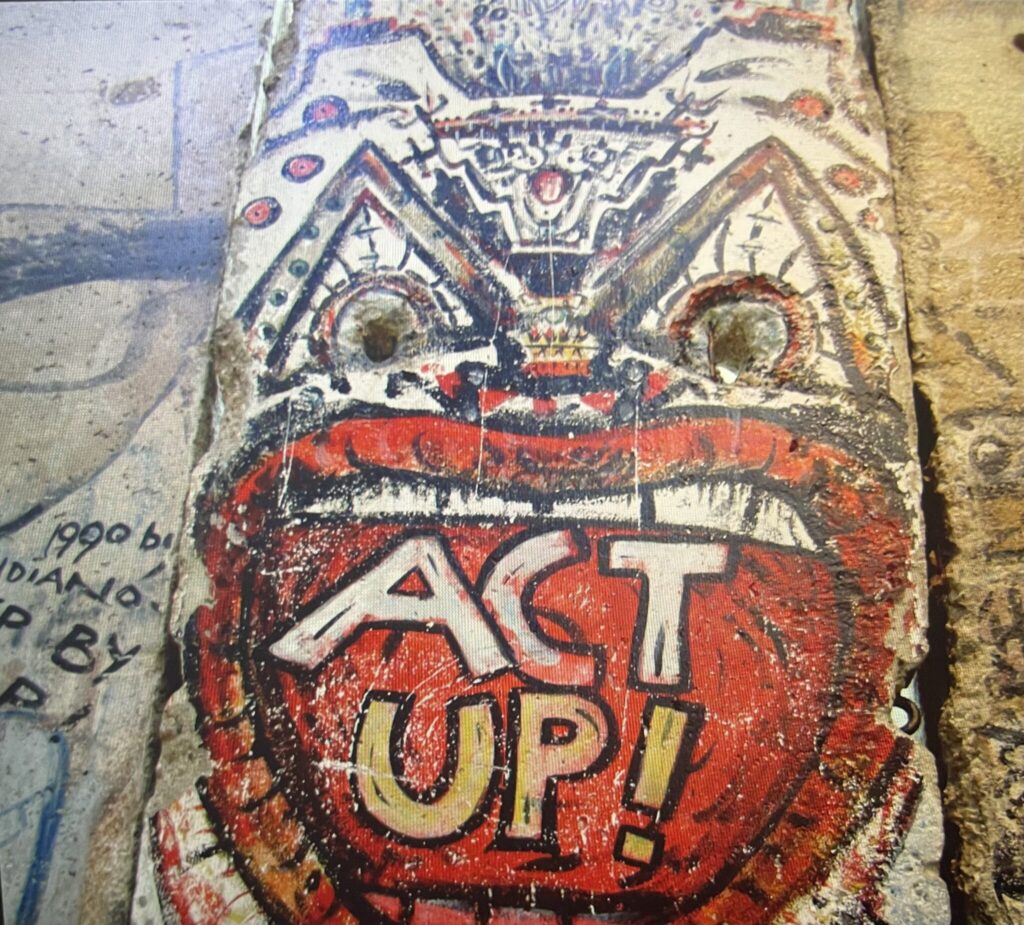
This image was from the berlin wall protests.The berlin wall was known as an obvious obstruction of human freedom. The wall was a blank canvas so local artists started to paint their worries and their hopes of people standing together and fighting for their rights. Now we know this to be artistic activism. This eventually led to covering the entire wall of art to tell their government they did not approve of the wall’s existence. The people of west-berlin gathered to make art to show the world this was an unjust act to separate in a physical and political way. The wall was eventually was taken down on November of 1988.
Discussion #13

In 2018, young people refused the status quo. On February 14, a mass shooting at Stoneman Douglas High School in Parkland, Florida left 17 people dead. Rather than allowing this cycle of violence to continue, the student survivors launched a massive youth-led movement for common sense gun safety reform. The “March for Our Lives” in Washington, D.C., helped to galvanize gun-control supporters. States across the country, including 14 with Republican governors, enacted 50 new laws restricting access to guns in the wake of the Stoneman Douglas shooting in Parkland, Florida.
“Legislators are starting to realize that mass shootings can happen in their state anytime,” said Allison Anderman, the managing attorney at the Giffords Law Center, a gun-control organization founded by former U.S. Rep. Gabby Giffords, the Arizona Democrat who survived a shooting in 2011. “And they don’t want to be in a position that this kind of thing can happen in their state at all.” State lawmakers still managed to expand gun access with at least 10 new laws in seven states. These measures — from allowing guns in K-12 schools to bolstering “stand your ground” laws — continued to carry weight in certain parts of the country, even as the gun-control movement steadily gained steam elsewhere.
Mass shootings are common in this country. According to the Gun Violence Archive, an oft-cited nonprofit that tracks shootings. Mass shootings are defined as attacks where there are four or more fatal and nonfatal injuries, not including the shooter. Appalling shootings involving students aren’t new either. There have been more than 260 school shootings since the national consciousness was shaken in 2012 when 20 first-graders and six school staff were slaughtered in Newtown, Connecticut, Gun Violence Archive data show, but when the words “enough is enough” rang out from the students at Marjory Stoneman Douglas High School, all of them members of the mass shooting generation — the millions born after Columbine in 1999, who practiced “code red” drills at school their entire lives — lawmakers started listening.
Nasser Ali – Discussion 13
My choice for art that I believe is activist is a piece named Straight, by Ai Weiwei, a Chinese contemporary artist, and activist. It is made up of 90 tons of steel that were destroyed in the Sichuan earthquake of 2008. This steel was retrieved from the many schools that were obliterated by the earthquake and were thoroughly straightened to create the piece. The steel is sorted to portray the fault line that lies under the province of Sichuan. The aim of this is to commemorate the lives lost, particularly the lives of over 5,000 children attending the schools. Ai Weiwei also directed the purpose of Straight to directly criticize unregulated construction companies and corrupt officials of the Chinese government as the schools were not only poorly built but also built directly on these fault lines that caused the earthquake.
Ai was persecuted for the piece and was detained for several days in prison.
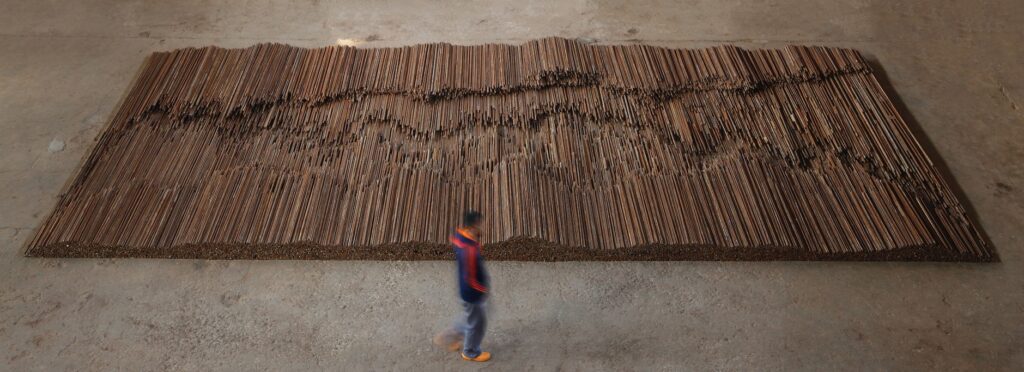
Anna Serbina Discussion 13
I would like to share photos of a performance “Ablutions” (1972) by Judy Chicago, Suzanne Lacy, Sandra Orgel and Aviva Rahmani. The project concerned rape and was based on the audio recordings of experiences of women who had been raped. Here is the description of the performance that I took from Lacy’s website:
Three body-sized galvanized metal tubs on the concrete floor were each filled with a different substance—eggs, blood, and clay. Around the tubs broken eggshells, piles of rope and chain, and animal kidneys were strewn. The soundtrack played continuously, one woman after the other telling the intimate and explicit details of their rapes—information not part of public culture at that time. A nude woman was slowly bound from feet to scalp with gauze bandages while two others bathed in the tubs, first eggs, then blood, then clay. As each one emerged from the final tub, caked with clay cracked to reveal rivulets of blood, and was wrapped like a corpse in a sheet. Throughout the performance, Lacy nailed 50 beef kidneys to the wall, encasing the room like a spinal column sur- rounded by its organs. The performance ended with two women—Lacy and Jan Lester, the bandager—stringing light rope over the set, until the performance stage was a spider web of entrapment. The voices on the tape droned on as if there was no escape from the brutalization, ending with the audio tape stuck on a chilling note, repeating like a broken record: “I felt so helpless, all I could do was just lie there.”

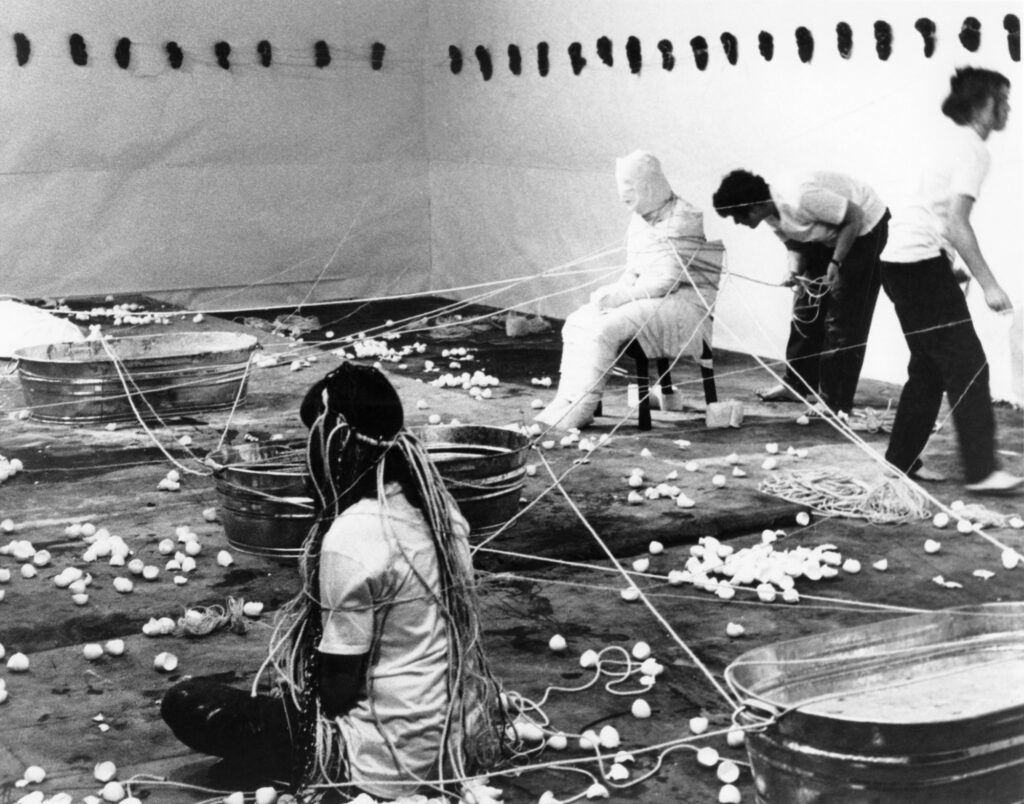
I chose it after seeing one of Judy Chicago’s paintings in an art museum and looking up her other works. The amount of work behind this performance and how “graphic” it is drew my attention. I view it as activism because it drew attention to a really big problem, considering the fact that marital rape was not criminalized in all states until the 90s. This performance could also inspire other women to speak up, following the example of the performers and recorded women.
Sydney Maldonado – Discussion Board #13
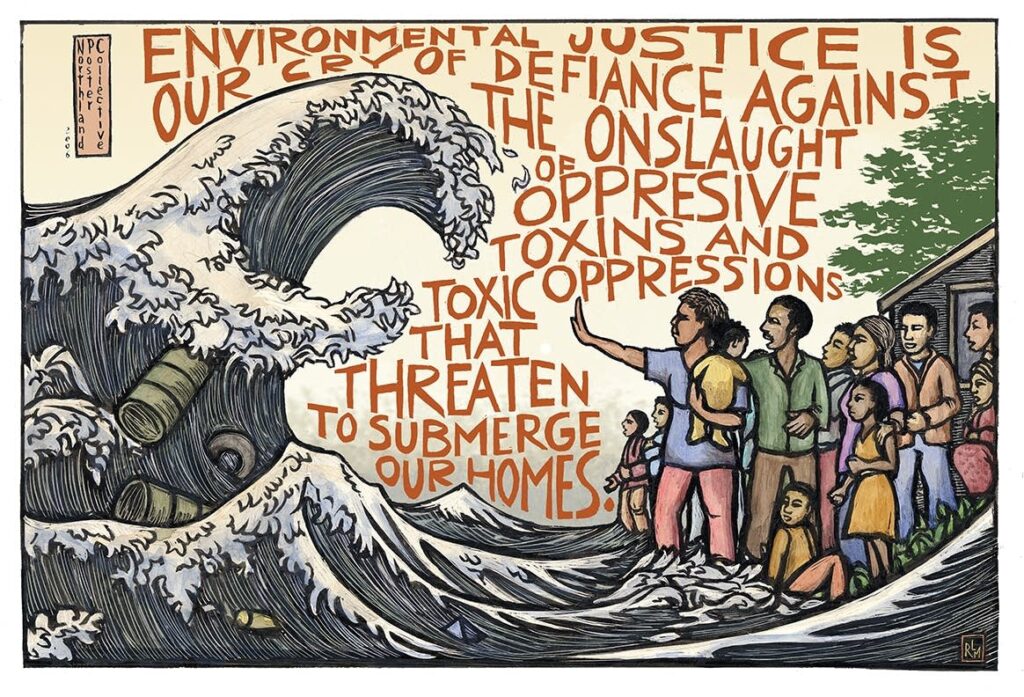
I chose this Ricardo Levins Morales piece “Environmental Justice” because it is based around such an important crucial topic of the environmental justice movement. As we know, there is still a constant battle to push for more environmentally friendly ways in which we can salvage our planet from the damage that has already been done. Ricardo Levins Morales was born into the anti-colonial movement in his native Puerto Rico and was later drawn into activism in Chicago when he moved with his family in 1967. Morales uses his art as a form of political medicine to support individuals, groups, or organizations that suffer from some sort of oppression or several different types of oppressions at once. This piece really spoke to me because not only the quote within the art is powerful but what the art is dissecting and representing the cause and effects of constantly polluting and destroying the planet. In this piece, there is a strong and powerful tidal wave caused by environmental destruction, native people including women, men, families, and young children standing up to this wave to fight for their land and overall, their planet. I think Morales’s overall message from this piece “Environmental Justice” is the fact that we need to speak up, stand out, and take action of the environmental justice movement, a social movement that seeks to address and address the inequitable distribution of environmental hazards among the poor and minorities.
Melissa. Valle Discussion #13
Melissa Valle Discussion 13

Frida Kahlo: a feminist figure, a brilliant artist, and the original icon for strong brows. Invented Traditions (Tradiciones Inventadas) examines Kahlo’s use of clothing and hairstyles to craft her own appearance, much the same way she used paint to create images on canvas. Featuring textiles and garments as pieces of art popular, the exhibit includes a local Tehuana dress that was a signature aspect of Kahlo’s personal style. Jackson Cole Phillips, an American industrialist, friend of Kahlo’s.
This piece of art caught my eye because of her unmistakable bold brows her light
mustache, yet she still has a beautiful look to herself. Like no matter what I am beautiful and that everyone should embrace their looks no matter what. So beautiful.
Food Zheng – Discussion #13
I chose Otto Dix’s art “The War Triptych”, since we can see the realism that existed in the time of war. A German artist, who was in the first world war, tried to give the reflections that he witnessed in reality but doing it in an artistic activist way. It is said that he was one of the first artists to be expelled from the Academy for simply doing very realistic, disgusting and dark art. But that is the reason why he does this kind of art, because he feels the need to show the reality of things. He did not try to embellish or show the beautiful things that a war brings, but rather he shows all the bad that it can bring to the country and to all people. Dix created these arts as a redemption to which he denounced the atrocities of wars, if we look at the painting and look at all the soldiers who gave their lives in a senseless war. Everything that all those people had to go through, who had no choice but to fight and defend their country. I understand that many times art is being able to see things beyond the sadness, but I feel that Dix did a great job in being able to show us the bad side of things. Many times we will just want to forget the atrocities, when in part I feel that we can learn from them so as not to repeat them or maybe just to avoid things.
